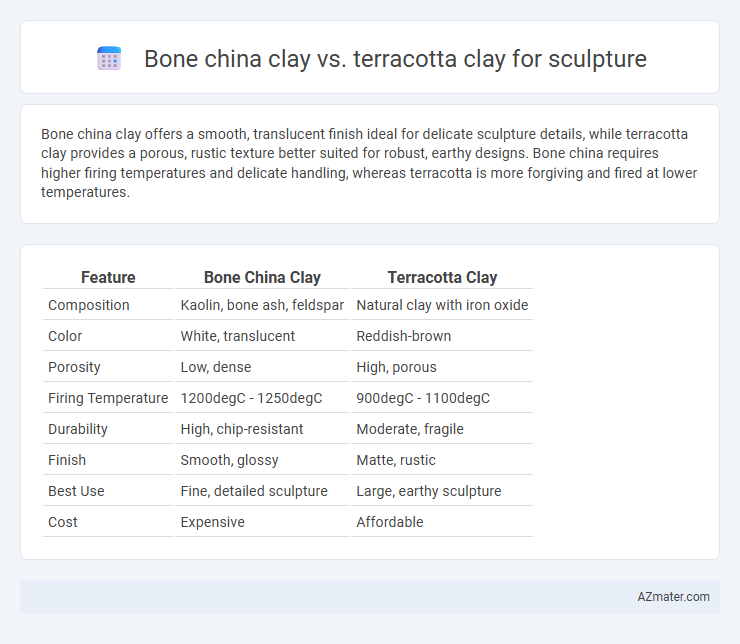Bone china clay offers a smooth, translucent finish ideal for delicate sculpture details, while terracotta clay provides a porous, rustic texture better suited for robust, earthy designs. Bone china requires higher firing temperatures and delicate handling, whereas terracotta is more forgiving and fired at lower temperatures.
Table of Comparison
| Feature | Bone China Clay | Terracotta Clay |
|---|---|---|
| Composition | Kaolin, bone ash, feldspar | Natural clay with iron oxide |
| Color | White, translucent | Reddish-brown |
| Porosity | Low, dense | High, porous |
| Firing Temperature | 1200degC - 1250degC | 900degC - 1100degC |
| Durability | High, chip-resistant | Moderate, fragile |
| Finish | Smooth, glossy | Matte, rustic |
| Best Use | Fine, detailed sculpture | Large, earthy sculpture |
| Cost | Expensive | Affordable |
Introduction to Bone China Clay and Terracotta Clay
Bone china clay, known for its fine texture and high translucency, is primarily composed of kaolin, feldspar, and bone ash, making it ideal for delicate, detailed sculptures with a smooth finish. Terracotta clay, rich in iron oxide, offers a porous, reddish-brown material that is durable and excellent for rustic, earthy sculptures with a natural aesthetic. Both clays serve distinct artistic purposes, with bone china clay favored for refined, intricate pieces and terracotta clay preferred for robust, expressive works.
Origins and Composition of Bone China Clay
Bone china clay originates from a unique blend of kaolin, feldspar, and bone ash derived from animal bones, providing exceptional whiteness, translucency, and strength. Its high calcium phosphate content from bone ash differentiates it significantly from terracotta clay, which is primarily composed of iron-rich earthenware clay with lower firing temperatures and porous texture. This composition makes bone china ideal for delicate, fine sculptures, while terracotta suits more rustic, durable forms.
Characteristics of Terracotta Clay
Terracotta clay is a porous, earthenware material known for its reddish-brown color and excellent plasticity, making it highly suitable for hand-building sculptures. It fires at lower temperatures compared to bone china clay, resulting in a more rustic, matte finish that enhances the natural textures of sculpted forms. Its affordability and ease of use make terracotta a popular choice for artists seeking organic, earthy aesthetics in their ceramic sculptures.
Workability and Sculpting Techniques
Bone china clay offers exceptional workability due to its fine particle size and plasticity, allowing for precise detailing and smooth finishes in sculpture. Terracotta clay, while coarser and less plastic, provides a more forgiving medium suitable for bold and textured sculpting techniques. Artists often choose bone china for intricate, delicate forms, whereas terracotta excels in earthy, rustic styles with robust hand-building methods.
Firing Temperatures and Processes
Bone china clay requires high firing temperatures typically between 1200degC and 1300degC, resulting in a hard, translucent finish ideal for delicate, detailed sculptures. Terracotta clay fires at much lower temperatures, usually around 1000degC to 1100degC, producing a porous, earthy texture that suits rustic, robust sculptural forms. The firing process for bone china involves multiple stages, including bisque and glaze firings, while terracotta often undergoes a single-stage firing without glazing.
Strength and Durability Comparison
Bone china clay exhibits higher strength and durability for sculpture compared to terracotta clay due to its fine particle size and high firing temperature, resulting in a dense, vitrified body resistant to chipping and cracking. Terracotta clay, fired at lower temperatures, remains porous and more susceptible to wear, making it less durable for outdoor or handling-intensive sculptures. For long-lasting artworks requiring fine detail and resilience, bone china clay is often the preferred material.
Surface Finish and Textural Qualities
Bone china clay offers a smooth, refined surface finish ideal for detailed sculptures, with a translucent quality that enhances light interaction. Terracotta clay features a coarser texture, producing a matte, earthy finish that emphasizes rustic and organic aesthetics. Surface porosity in terracotta allows for rich textural variations, while bone china provides a polished, sleek appearance favored in fine art sculptures.
Color Variations and Aesthetic Appeal
Bone china clay offers a translucent, smooth texture with a pure white base that enhances vibrant glazes and fine details, making it ideal for delicate, refined sculptures. Terracotta clay exhibits warm, earthy tones ranging from rich reds to deep browns, providing a natural, rustic aesthetic that highlights organic forms and textures. The color variations in terracotta emphasize a raw, traditional appeal, while bone china clay's subtle, luminous finish adds sophistication and elegance to sculptural works.
Suitable Sculpture Applications
Bone china clay, known for its fine texture, high strength, and white translucent finish, is ideal for intricate and delicate sculptures requiring smooth surfaces and detailed features, especially in small to medium-sized decorative art pieces. Terracotta clay, with its coarse texture and porous reddish-brown appearance, suits larger, rustic, and outdoor sculptures that benefit from its durability and earthy aesthetic, making it perfect for garden art and traditional figurines. Sculptors select bone china clay when precision and elegance are paramount, while terracotta clay is preferred for robust, weather-resistant creations.
Choosing the Right Clay for Your Sculpture Project
Bone china clay offers a smooth texture and fine particle size, ideal for detailed and delicate sculptures requiring translucency and strength. Terracotta clay, with its porous nature and warm earthy tones, is preferred for rustic, larger-scale outdoor sculptures and provides excellent workability and durability after firing. Selecting the right clay depends on the desired finish, project scale, and firing conditions to ensure optimal structural integrity and aesthetic appeal.

Infographic: Bone china clay vs Terracotta clay for Sculpture
 azmater.com
azmater.com